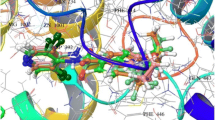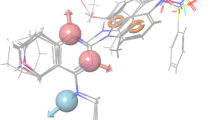Abstract
The 3-phosphoinositide-dependent protein kinase-1 (PDK1) is an imminent target for discovering novel anticancer drugs. In order to understand the structure–activity correlation of naphthyridine-based PDK-1 inhibitors, we have carried out a combined pharmacophore, three-dimensional quantitative structure–activity relationship (3D-QSAR), and molecular docking studies. The study has resulted in six point pharmacophore models with four hydrogen bond acceptors (A), one hydrogen bond donor (D), and one aromatic ring (R) are used to derive a predictive atom-based 3D-QSAR model. The generated 3D-QSAR model shows that the alignment has good correlation coefficient for the training set compounds which comprises the values of R 2 = 0.96, SD = 0.2, and F = 198.2. Test set compounds shows Q 2 = 0.84, RMSE = 0.56, and Pearson-R = 0.84. The external validation was carried out to validate the predicted QSAR model which shows good predictive power of \( r_{m}^{2} \) = 0.83 and k = 1.01, respectively. The external validation results also confirm the fitness of the model. The results indicated that, atom-based 3D-QSAR models and further modifications in PDK1 inhibitors via pharmacophore hypothesis are rational for the prediction of the activity of new inhibitors in prospect of drug design.





Similar content being viewed by others
References
Alessi DR, Deak M, Casamayor A, Caudwell FB, Morrice N, Norman DG, Gaffney P, Reese CB, MacDougall CN, Harbison D, Ashworth A, Bowenes M (1997a) 3-Phosphoinositide-dependent protein kinase-1 (PDK1): structural and functional homology with the Drosophila DSTPK61 kinase. Curr Biol 7:776–789
Alessi DR, James SR, Downes CP, Holmes AB, Gaffney PRJ, Reese CB, Cohen P (1997b) Characterization of a 3-phosphoinositide-dependent protein kinase which phosphorylates and activates protein kinase Balpha. Curr Biol 7:261–269
Baryawno N, Sveinbjornsson B, Eksborg S, Chen CS, Kogner P, Johnsen JI (2010) Small-molecule inhibitors of phosphatidylinositol 3-kinase/Akt signaling inhibit Wnt/β-catenin pathway cross-talk and suppress medulloblastoma growth. Cancer Res 70:266–276
Basu A, Jasu K, Jayaprakash V, Mishra N, Ojha P, Bhattacharya S (2009) Development of CoMFA and CoMSIA models of cytotoxicity data of anti-HIV-1-phenylamino-1H-imidazole derivatives. Eur J Med Chem 44:2400–2407
Bayascas JR, Leslie NR, Parsons R, Fleming S, Alessi DR (2005) Hypomorphic mutation of PDK1 suppresses tumorigenesis in PTEN (±) mice. Curr Biol 15:1839–1846
Belham C, Wu S, Avruch J (1999) Intracellular signalling: PDK1 a kinase at the hub of things. Curr Biol 9:R93–R96
Berman HM, Westbrook J, Feng Z, Gilliland G, Bhat TN, Weissig H, Shindyalov IN, Bourne PE (2000) The protein data bank. Nucleic Acids Res 28:235–242
Brazil DP, Hemmings BA (2001) Ten years of protein kinase B signalling: a hard Akt to follow. Trends Biochem Sci 26:657–664
Cheng JQ, Lindsley CW, Cheng GZ, Yang H, Nicosia SV (2005) The Akt/PKB pathway: molecular target for cancer drug discovery. Oncogene 24:7482–7492
Cohen P (2002) Protein kinases—the major drug targets of the twenty-first century? Nat Rev Drug Discov 1:309–315
Currie RA, Walker KS, Gray A, Deak M, Casamayor A, Downes CP, Cohen P, Alessi DR, Lucocq J (1999) Role of phosphatidylinositol 3,4,5-trisphosphate in regulating the activity and localization of 3-phosphoinositide-dependent protein kinase-1. Biochem J 337:575–583
De Roock W, Piessevaux H, De Schutter J, Janssens M, De Hertogh G, Personeni N, Biesmans B, Van Laethem JL, Peeters M, Humblet Y, Van Cutsem E, Tejpar S (2008) KRAS wild-type state predicts survival and is associated to early radiological response in metastatic colorectal cancer treated with cetuximab. Ann Oncol 19:508–515
Di Nicolantonio F, Martini M, Molinari F, Sartore-Bianchi A, Arena S, Saletti P, De Dosso S, Mazzucchelli L, Frattini M, Siena S, Bardelli A (2008) Wild-type BRAF is required for response to panitumumab or cetuximab in metastatic colorectal cancer. J Clin Oncol 26:5705–5712
Dixon S, Smondyrev A, Knoll E, Rao S, Shaw D, Friesner R (2006a) PHASE: a new engine for pharmacophore perception, 3D QSAR model development, and 3D database screening: 1. Methodology and preliminary results. J Comput Aided Mol Des 20:647–671
Dixon SL, Smondyrev AM, Rao SN (2006b) PHASE: a novel approach to pharmacophore modeling and 3D database searching. Chem Biol Drug Des 67:370–372
Eglen RM, Reisine T (2009) The current status of drug discovery against the human kinome. Assay Drug Dev Technol 7:22–43
Evans DA, Doman TN, Thorner DA, Bodkin MJ (2007) 3D QSAR methods: phase and catalyst compared. J Chem Inf Model 47:1248–1257
Feldman RI, Wu JM, Polokoff MA, Kochanny MJ, Dinter H, Zhu D, Biroc SL, Alicke B, Bryant J, Yuan S, Buckman BO, Lentz D, Ferrer M, Whitlow M, Adler M, Finster S, Chang Z, Arnaiz DO (2005) Novel small molecule inhibitors of 3-phosphoinositide-dependent kinase-1. J Biol Chem 280:19867–19874
Flynn P, Wong M, Zavar M, Dean NM, Stokoe D (2000) Inhibition of PDK-1 activity causes a reduction in cell proliferation and survival. Curr Biol 10:1439–1442
Fujita N, Tsuruo T (2003) Survival-signaling pathway as a promising target for cancer chemotherapy. Cancer Chemother Pharmacol 52:24–28
Gao N, Flynn DC, Zhang Z, Zhong XS, Walker V, Liu KJ, Shi X, Jiang BH (2004) G1 cell cycle progression and the expression of G1 cyclins are regulated by PI3K/AKT/mTOR/p70S6K1 signaling in human ovarian cancer cells. Am J Physiol Cell Physiol 287:281–291
Garber K (2006) The second wave in kinase cancer drugs. Nat Biotechnol 24:127–130
Golbraikh A, Tropsha A (2002) Beware of q2! J Mol Graph Model 20:269–276
Gopalsamy A, Shi M, Boschelli DH, Williamson R, Olland A, Hu Y, Krishnamurthy G, Han X, Arndt K, Guo B (2007) Discovery of dibenzo[c,f][2,7]naphthyridines as potent and selective 3-phosphoinositide-dependent kinase-1 inhibitors. J Med Chem 50:5547–5549
Kim JA (2003) Targeted therapies for the treatment of cancer. Am J Surg 186:264–268
Kim D, Chung J (2002) Akt: versatile mediator of cell survival and beyond. J Biochem Mol Biol 35:106–115
Kim KH, Wissner A, Floyd MB Jr, Fraser HL, Wang YD, Dushin RG, Hu Y, Olland A, Guo B, Arndt K (2009) Benzo[c][2,7]naphthyridines as inhibitors of PDK-1. Bioorg Med Chem Lett 19:5225–5228
Komander D, Kular G, Deak M, Alessi DR, van Aalten DMF (2005) Role of T-loop phosphorylation in PDK1 activation, stability, and substrate binding. J Biol Chem 280:18797–18802
Lawlor MA, Mora A, Ashby PR, Williams MR, Murray-Tait V, Malone L, Prescott AR, Lucocq JM, Alessi DR (2002) Essential role of PDK1 in regulating cell size and development in mice. EMBO J 21:3728–3738
Lin HJ, Hsieh FC, Song H, Lin J (2005) Elevated phosphorylation and activation of PDK-1/AKT pathway in human breast cancer. Br J Cancer 93:1372–1381
Lu P, Wei X, Zhang R (2010) CoMFA and CoMSIA 3D-QSAR studies on quionolone caroxylic acid derivatives inhibitors of HIV-1 integrase. Eur J Med Chem 45:3413–3419
Manning G, Whyte DB, Martinez R, Hunter T, Sudarsanam S (2002) The protein kinase complement of the human genome. Science 298:1912–1934
Mora A, Komander D, van Aalten DMF, Alessi DR (2004) PDK1, the master regulator of AGC kinase signal transduction. Semin Cell Dev Biol 15:161–170
Newton AC (2003) Regulation of the ABC kinases by phosphorylation: protein kinase C as a paradigm. Biochem J 370:361–371
Nittoli T, Dushin RG, Ingalls C, Cheung K, Floyd MB, Fraser H, Olland A, Hu Y, Grosu G, Han X, Arndt K, Guo B, Wissner A (2010) The identification of 8,9-dimethoxy-5-(2-aminoalkoxy-pyridin-3-yl)-benzo[c][2,7]naphthyridin-4-ylamines as potent inhibitors of 3-phosphoinositide-dependent kinase-1 (PDK-1). Eur J Med Chem 45:1379–1386
Perrotti N, He RA, Phillips SA, Haft CR, Taylor SI (2001) Activation of serum- and glucocorticoid-induced protein kinase (Sgk) by cyclic AMP and insulin. J Biol Chem 276:9406–9412
Pullen N, Dennis PB, Andjelkovic M, Dufner A, Kozma SC, Hemmings BA, Thomas G (1998) Phosphorylation and Activation of p70s6k by PDK1. Science 279:707–710
Roy PP, Roy K (2008) On some aspects of variable selection for partial least squares regression models. QSAR Comb Sci 27:302–313
Sahoo S, Brickley DR, Kocherginsky M, Conzen SD (2005) Coordinate expression of the PI3-kinase downstream effectors serum and glucocorticoid-induced kinase (SGK-1) and Akt-1 in human breast cancer. Eur J Cancer 41:2754–2759
Smith JA, Poteet-Smith CE, Xu Y, Errington TM, Hecht SM, Lannigan DA (2005) Identification of the first specific inhibitor of p90 ribosomal S6 kinase (RSK) reveals an unexpected role for RSK in cancer cell proliferation. Cancer Res 65:1027–1034
Telvekar V, Kundaikar H, Patel K, Chaudhari H (2008) 3-D QSAR and molecular docking studies on aryl benzofuran-2-yl ketoxime derivatives as Candida albicans N-myristoyltransferase inhibitors. QSAR Comb Sci 27:1193–1203
Toker A, Newton AC (2000) Cellular Signaling: pivoting around PDK-1. Cell 103:185–188
Tropsha A (2005) In: Oprea TI (ed) Chemoinformatics in drug discovery. Wiley, Weinheim, pp 437–455
Zeng X, Xu H, Glazer RI (2002) Transformation of mammary epithelial cells by 3-phosphoinositide-dependent protein kinase-1 (PDK1) is associated with the induction of protein kinase Cα. Cancer Res 62:3538–3543
Author information
Authors and Affiliations
Corresponding author
Rights and permissions
About this article
Cite this article
Kirubakaran, P., Muthusamy, K., Dhanachandra Singh, K. et al. Pharmacophore modeling, 3D-QSAR, and molecular docking study on naphthyridine derivatives as inhibitors of 3-phosphoinositide-dependent protein kinase-1. Med Chem Res 22, 3812–3822 (2013). https://doi.org/10.1007/s00044-012-0383-5
Received:
Accepted:
Published:
Issue Date:
DOI: https://doi.org/10.1007/s00044-012-0383-5




